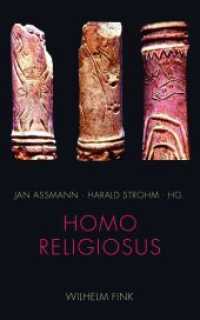- ホーム
- > 洋書
- > 英文書
- > Politics / International Relations
Full Description
Bryan D. Palmer reinterprets the history of labour and the left in the United States during the 1930s through a discussion of the emergence of Trotskyism in the most advanced capitalist country in the world. Focussing on James P. Cannon, the founder of American Trotskyism, Palmer builds on his previously published and award-winning book, James P. Cannon and the Origins of the American Revolutionary Left, 1890-1928 (2007), with a deeply-researched and elegantly-written study of Cannon and the Trotskyist movement in the United States from 1928-38.
Situating this dissident communist movement within the history of class struggle, both national and international, Palmer examines how Cannon and others fought to revive a combative trade unionism, thwart fascism and the drift to war, refuse Stalinism's many degenerations, and build a new Party and a new International, both of which would be dedicating to reviving and realizing the possibilities of revolutionary socialism. The result is a study that provides a definitive account of the largest and most influential Trotskyist movement in the world in the 1930s, a mobilization whose history recasts understandings of the more extensively-studied experience of United States working-class militancy and the place of the Comintern-affiliated Communist Party within it.
Contents
Preface and Acknowledgments
List of Figures
Introduction: James P. Cannon and the "Prince's Favors"
1 Hope and the Dog Days
2 Historiography's House of Mirrors
3 Mirror Image Refusals
4 Analytic Alternative
5 Cannon and the History of American Trotskyism
1 An American Left Opposition
1 Exile off Main Street
2 Stalinism Consolidating
3 Stalinist Slow Dancing: Guile
4 Picking up the Pace: Gangsterism
5 Recruiting the American Left Opposition: Three Phases
6 Cannon: Caretaker of the Original Left Opposition Cadre
7 Recruitment's Second Phase: Stalinism's Heavy Hand
8 "An Army of a Million People": Hungarians, Italians, Finns, and Immigrant Birth Controllers
9 A Publication Program
10 The Founding of the Communist League of America (Opposition)
2 Dog Days
1 Downturn: Economic Depression
2 "Left Turn": Revolutionary Politics and the Third Period
3 Dimensions of Cannon's Crisis: Material Being
4 Dimensions of Cannon's Crisis: Reconstituted Families and Domestic Complications
5 Dimensions of Cannon's Crisis: Rose Karsner's Break-Down
6 Cannon's Collapsing World: The Personal Becomes Political
7 The Weisbord Whirlwind
8 Branch Bickerings: New York Cliquism and Youth Recruits
9 Factional Waystation: June 1932, National Committee Plenum
10 Factionalism Internationalized: The Turn to Europe
11 International Intervention
12 Dog Days Denouement: New Turns
13 Internal Ironies
3 Daylight: Analysis and Action
1 1933-34: Past, Present, and Future
2 Context: Revival/Reorientation
3 The Long and Trying March Back to a Labor Party Perspective
4 Black Oppression in America: National Self-Determination vs. The Revolutionary Struggle for Equality
5 The Momentum of Mobilizations: Unemployed and Labor Defense Work
6 Miner Militants: Cannon's "Bona Fide Proletarians"
7 B.J. Field: A Napoleon among New York's French Chefs
8 Dawn of a New Left Opposition Day
4 Minneapolis Militants
1 General Strike
2 Class Relations in Minneapolis
3 Trotskyists among the Teamsters: Propagandistic Old Moles
4 January Thaw; February Cold Snap: The Coal Yards on Strike
5 Lessons of the Coal Yards Strike
6 Strike Preparations: Unemployed Agitations and Industrial Unionism
7 Overcoming "Bureaucratic Obstacles"
8 The Ladies/Women's Auxiliary
9 Rebel Outpost: 1900 Chicago Avenue
10 The Tribune Alley Plot and the Battle of Deputies Run
11 May 1934: Settlement Secured; Victory Postponed
12 Stalinist Slurs
13 Farmer-Labor Two Class Hybrid vs Class Struggle Perspective
14 Interlude
15 Toward the July Days
16 A Strike Declared; A Plot Exposed
17 Bloody Friday
18 Labor's Martyr: Henry B. Ness
19 Martial Law/Red Scare
20 Olson: The Defective "Merits" of a Progressive Pragmatism
21 Standing Fast: Satire and Solidarity
22 Mediation's Meanderings
23 Sudden and Unexpected Victory
5 Entryism
1 1934: Militancy and Marginalization's Movement
2 The French Turn
3 Cannon, Trotsky, and the Preparatory Ground of Entryism: Transcending the "Organic Unity" Imbroglio
4 Fusion with the Musteites
5 Building the Party amid Fusion's Fallouts
6 Anticipating the French Turn
7 Americanizing the French Turn: Factions and Combinations
8 The Intensification of Oehlerite Sectarianism
9 Ousting the Oehlerites
10 Socialist Party Schisms and Workers Party Entry
11 Prelude to Entry: Cannon in Harness and Muste's Conversions
12 Entryism & Subordination
13 A Farmer-Labor Detour and the Return of the Oehlerite Repressed
14 Entry Proclaimed
15 Cannon in California: The "Foot Loose Rebel" and the Agitational Road
16 Entryist Estrangement
17 The Return of the Prodigal Agitator
18 Reaction from Above
19 The End of Entry
20 Assessing the French Turn in America
6 Trials, Tragedies, and Trade Unions
1 1937's Imperative: Assimilating Revolution's Recruits
2 The Origins of the American Committee for the Defense of Leon Trotsky
3 The Non-partisan Origins of Trotsky's Defense
4 Dancing with Dewey
5 Trotsky's Testimony
6 Carleton Beals and Stalinism at Work in the Preliminary Sub-commission
7 Delimitation by Default
8 Social-Democratic Delimitation
9 Brand Barcelona on Centrist Foreheads: Trotskyism and the Spanish Civil War
10 Trotskyism Finds its "Sea Legs": Cannon and the Maritime Federation of the Pacific
11 Frame-Up in Minneapolis: Who Killed Patrick J. Corcoran?
12 Trotskyism on the Line: Footholds in Mass Production and the CIO
Conclusion: Party/International
References
Index








